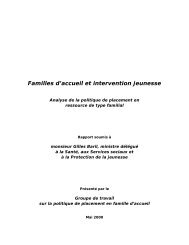Intimacy in adolescent sexual relations - MSSS/Notice/Copyright ...
Intimacy in adolescent sexual relations - MSSS/Notice/Copyright ...
Intimacy in adolescent sexual relations - MSSS/Notice/Copyright ...
You also want an ePaper? Increase the reach of your titles
YUMPU automatically turns print PDFs into web optimized ePapers that Google loves.
As stressed by Chou<strong>in</strong>ard (2005, p. 2), when the subject of <strong>adolescent</strong><br />
<strong>sexual</strong>ity is discussed, it is “never a question of happ<strong>in</strong>ess, but of<br />
performance, dom<strong>in</strong>ation, social pressures, <strong>in</strong>fections ... and the<br />
search for love.” For Robert (2005, p. 13), it is as if “you had lost your<br />
bear<strong>in</strong>gs, the sense of distance and rituals, the sense of a time for<br />
wait<strong>in</strong>g and a time for desire, the sense of taste, the sense of happ<strong>in</strong>ess<br />
and of the sacred, the exceptional and of moments of grace,<br />
and maybe especially the sense of the value of values. The zeitgeist<br />
calls for immediacy, uniformity, anyth<strong>in</strong>g permitted anytime, right<br />
away, all alone, and very blunt!” In the context of orogenital<br />
<strong>in</strong>tercourse, this quote reflects the advantage of progression <strong>in</strong> <strong>sexual</strong><br />
contacts. As we have stated above, the trivialization of oral sex is<br />
such that <strong>adolescent</strong>s sometimes engage <strong>in</strong> this <strong>sexual</strong> practice<br />
before they have even kissed someone for the first time. Yet, a kiss<br />
“br<strong>in</strong>gs the soul, thoughts, and feel<strong>in</strong>gs of the other closer. It l<strong>in</strong>ks<br />
feel<strong>in</strong>g and sensation, and distils consciousness awareness between<br />
two be<strong>in</strong>gs. Many people see the kiss as the way to <strong>in</strong>troduce<br />
affectionate communication <strong>in</strong>to <strong>sexual</strong> <strong>relations</strong>.”<br />
Participants <strong>in</strong> a recent study carried out by Halpern-Felsher et al.<br />
and cited above seem to associate psychoaffective risks more with<br />
vag<strong>in</strong>al penetration than with oral sex. More of them, <strong>in</strong> fact, mention<br />
the risks that the couple <strong>relations</strong>hip could deteriorate, that they<br />
could acquire a poor reputation, or experience problems or feel guilty<br />
<strong>in</strong> the case of <strong>sexual</strong> <strong>in</strong>tercourse with vag<strong>in</strong>al penetration. This lack<br />
of awareness of the consequences of the practice of oral sex shows<br />
the need for educational <strong>in</strong>terventions so as to <strong>in</strong>form <strong>adolescent</strong>s of<br />
these risks and, consequently, of the importance of protect<strong>in</strong>g<br />
themselves just as for <strong>in</strong>tercourse with vag<strong>in</strong>al penetration.<br />
NOT ALL ADOLESCENTS HAVE ORAL INTERCOURSE<br />
Of course, not <strong>adolescent</strong>s practice oral sex. Moreover, discussions of<br />
<strong>sexual</strong>ity, and more particularly explicit discussions of <strong>sexual</strong><br />
practices, make a number of them ill at ease. In fact, without be<strong>in</strong>g<br />
ignorant of oral sex, many <strong>adolescent</strong>s have never heard the word<br />
fellatio (Boiv<strong>in</strong>, 2004). In your <strong>in</strong>terventions, you must take care not to<br />
th<strong>in</strong>k all <strong>adolescent</strong>s are at the same level, so as to not exacerbate<br />
their discomfort. Moreover, some of them may feel <strong>in</strong>timidated by<br />
hav<strong>in</strong>g to discuss oral <strong>sexual</strong>ity <strong>in</strong> front of their peers. For these<br />
reasons, it is important that <strong>in</strong>terventions be conducted with respect,<br />
nuance, and delicacy. That be<strong>in</strong>g so, it should be made clear that<br />
peer pressure concern<strong>in</strong>g several forms of <strong>sexual</strong> practices, <strong>in</strong>clud<strong>in</strong>g<br />
oral sex, is felt even by those who are not yet <strong>sexual</strong>ly active.<br />
THE BEST TYPE OF INTERVENTION<br />
The perceptions, comments, and behaviours of <strong>adolescent</strong>s show that<br />
they trivialize the practice of oral sex. It seems, then, to be of first<br />
importance that educational <strong>in</strong>terventions should focus on sensitiz<strong>in</strong>g<br />
them to the <strong>in</strong>timate nature of this <strong>sexual</strong> practice. What characterizes<br />
<strong>in</strong>timacy is emotional closeness; the will<strong>in</strong>gness to open oneself to<br />
another; a feel<strong>in</strong>g of well be<strong>in</strong>g before, dur<strong>in</strong>g and after <strong>in</strong>timate<br />
contact; and affection, trust, oneness, and shar<strong>in</strong>g between partners.<br />
It is not a question of present<strong>in</strong>g oral <strong>in</strong>tercourse <strong>in</strong> a negative light,<br />
but of orient<strong>in</strong>g the <strong>in</strong>tervention on the fact that oral <strong>in</strong>tercourse<br />
should not be treated as trivially as it is.<br />
The question of the risks, both physical and psychoaffective, that are<br />
<strong>in</strong>curred with oral sex should also be broached so as to equip the<br />
<strong>adolescent</strong>s usefully for deal<strong>in</strong>g with these risks. Though the risks of<br />
STI and HIV transmission rema<strong>in</strong> relatively low, condom use is<br />
nonetheless advisable for oral <strong>in</strong>tercourse. As far as the psychoaffective<br />
risks are concerned, the appropriate pedagogic approach seems to be<br />
one of help<strong>in</strong>g <strong>adolescent</strong>s figure out what motivates them to have<br />
oral sex and what pressures they experience to have it, and help<strong>in</strong>g<br />
them demystify lust and pleasure. In sum, it is not a question of<br />
do<strong>in</strong>g everyth<strong>in</strong>g to be popular with others, or of believ<strong>in</strong>g that the<br />
quality of a <strong>relations</strong>hip is l<strong>in</strong>ked to the diversity of <strong>sexual</strong> practices,<br />
or to conformity to the <strong>sexual</strong> desires of the other, etc.<br />
With this <strong>in</strong> view, we propose <strong>in</strong>terventions that aim to make<br />
<strong>adolescent</strong>s reflect on what motivates them to adopt or refuse a<br />
particular <strong>sexual</strong> practice, so that they can beg<strong>in</strong> to th<strong>in</strong>k critically<br />
about oral <strong>in</strong>tercourse and, especially, that they become aware of its<br />
<strong>in</strong>timate character.<br />
On the general subject of the trivialization of certa<strong>in</strong> <strong>sexual</strong> activities<br />
among <strong>adolescent</strong>s (the sources of this trivialization, its repercussions,<br />
etc), we <strong>in</strong>vite you to consult the issue of Le petit Magaz<strong>in</strong>e de la<br />
formation personnelle et sociale entitled Les <strong>relations</strong> sexuelles<br />
<strong>adolescent</strong>es, est-ce banal ?, by Marie-Andrée Bossé, on the site<br />
www.msss.gouv.qc.ca/itss (click Documentation, then Professionnels<br />
de l’éducation).<br />
7

















